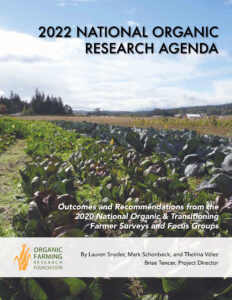 The Organic Farming Research Foundation 2022 National Organic Research Agenda (NORA) is a report informed by surveys and focus groups conducted in 2020 with over 1,100 certified organic farmers and ranchers across North America.
The Organic Farming Research Foundation 2022 National Organic Research Agenda (NORA) is a report informed by surveys and focus groups conducted in 2020 with over 1,100 certified organic farmers and ranchers across North America.
What Farmers Said
- In the NORA report, 83% of respondents reported used crop rotations at least sometimes, with the majority responding usage as very often.
- 88% of survey respondents used cover crops and green manures, with almost half of respondents indicating they cover crop very often.
- Only 19% of respondents indicated they intercropped very often and 36% reported never intercropping.
Download OFRF’s Soil health and organic farming guide books.
Cover Cropping by Region
Respondents from the South tended to use cover crops more often than in other regions. This may reflect the greater need for cover crops in the rotation to replenish soil organic matter (SOM) and nitrogen (N) in Southern region soils, which tend to lose SOM rapidly and have lower inherent fertility than soils in cooler parts of the U.S. (Duncan, 2017).
Cover crop use frequency was second highest in the Corn Belt region, where two-thirds of respondents grow field crops.
Conversely, the colder climates and shorter growing seasons in the Great Lakes and Northeast regions can impose logistical and economic constraints on integrating cover crops into annual crop rotations (Delate, 2013; Sheaffer et al., 2007). These challenges could contribute to less frequent use of cover crops.
Crop Rotations by Region
At least 88% of respondents in the most agro-ecoregions used crop rotations to some extent. However, within in the Pacific region, 35% of respondents reported never using crop rotations.
Across All Agro-Ecoregions
Perennial conservation plantings play important roles in agro-ecosystem health and in meeting NOP requirements to conserve biodiversity in organic operations. Across all agro-ecoregions, 74% of survey respondents reported maintaining some of their certified land in one or more of the following:
- buffer strips or border rows (54%);
- hedgerows, windbreaks or shelterbelts (35%);
- wildflower strips (17%);
- and other plantings such as woodland, prairie, or other natural areas (7%).
Other Conservation Practices to Help Improve Soil Health
Conservation Cover: Establish and maintain either introduced or native grasses, legumes and forbs for permanent cover, pollinator habitat, and food for wildlife.
Forage and Biomass Planting: Plant specific grass and legumes suitable for pasture, hay, or biomass production improves livestock nutrition and health, and can provide forage supplies during periods of low forage.
Manure Management: Store and contain manure until conditions are appropriate for field applications. This addresses potential manure runoff, protects water quality, and reduces nutrient loss.
Rotational Grazing of Animals: Divide pastures into multiple paddocks to manage soil compaction and harvest of vegetation. This improves or maintains the volume and quality of forage for grazing animals and provides vigor to plant communities.
Tree and Shrub Establishment: Woody plants in non-forested areas via planting seedlings, container/potted plants, cuttings or by direct seeding can improve air and water quality, stores carbon in biomass, provides wildlife habitat, and controls snow drift.


